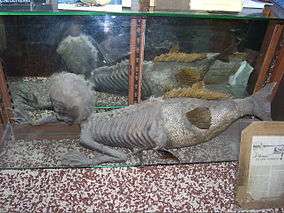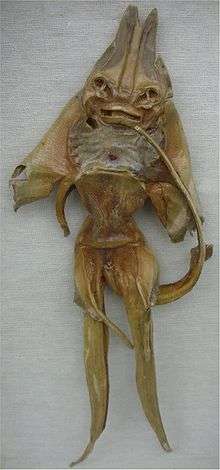Merman
Mermen, the counterparts of the mythical female mermaids, are legendary creatures, which are male human from the waist up and fish-like from the waist down, but may assume normal human shape. Sometimes they are described as hideous and other times as handsome.
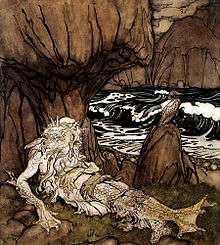 A Crowned Merman, by Arthur Rackham | |
| Grouping | Mythological |
|---|---|
| Sub grouping | Water spirit |
| Country | Worldwide |
Overview
The actions and behavior of mermen can vary wildly depending on the source and time period of the stories. They have been said to sink ships by summoning great storms, but also said to be wise teachers, according to earlier mythology. Mermen, just like mermaids, can lure and attract humans with their enchantingly beautiful, soft melodic and seductive siren-like singing voices and tones.
Antiquity
Perhaps the first recorded merman was the early Babylonian sea-god Ea, whose Sumerian Enki, and was known to the Greeks as Oannes. Oannes had a fish head and man's head beneath, and both a fish tail and man like legs, according to Berossus.[lower-alpha 1][1] The fish god Dagon of the Philistines, with a fish-tailed body, may derive its origins from these earlier Mesopotamian gods.[2]
Greco-Roman mythology
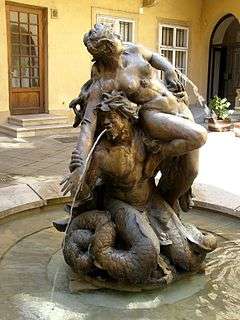
Triton of Greek mythology was depicted as a half-man, half-fish merman in ancient Greek art. Triton was son of the sea-god Poseidon and sea-goddess Amphitrite. Neither Poseidon nor Amphitrite were merfolk, although both were able to live under water as easily as on land.
Tritons later became generic mermen, so that multiple numbers of them were depicted in art.[3][4]
Triton were also associated with using a conch shell in the later Hellenistic period.[5] In the 16th century, the Triton was referred to as "trumpeter of Neptune (Neptuni tubicen)" in Marius Nizolius's Thesaurus (1551),[6][7] and this phrase has been use in modern commentary.[8] The Elizabethan period poet Edmund Spenser referred to Triton's "trompet" as well.[9]
Another notable merman from Greek mythology was Glaucus. He was born a human and lived his early life as a fisherman. One day, while fishing, he saw that the fish he caught would jump from the grass and into the sea. He ate some of the grass, believing it to have magical properties, and felt an overwhelming desire to be in the sea. He jumped in the ocean and refused to go back on land. The sea gods nearby heard his prayers and transformed him into a sea god. Ovid describes the transformation of Glaucus in the Metamorphoses, describing him as a blue-green man with a fishy member where his legs had been.
Medieval Period
In Medieval Europe, mermen were sometimes held responsible for causing violent storms and sinking ships.[10]
A twin-tailed merman is depicted on the Bianco world map (1436).[11][12][lower-alpha 2] A merman and a mermaid are shown on the Behaim globe (c. 1490–1493).[13]
Rennaissance Period
Gesner's sea-satyr

Konrad Gesner in his chapter on Triton (mythology) in Historia animalium IV (1558) gave the name of "sea-Pan" or "sea-satyr" (Latin: Pan- vel satyrus marinus) to an artist's image he obtained, which he said was that of an "ichthyocentaur" or "sea-devil".[14][15][16][17]
Gesner's sea-devil (German: Meerteufel) has been described by a modern commentator as having "the lower body of a fish and the upper body of a man, the head an horns of a buck-goat or the devil, and the breasts of a woman",[18] and lacks the horse-legs of a typical centaur. Gesner made reference to a passage where Aelian writes of satyrs that inhabit Taprobana's seas,[14] counted among the fishes and cete (Ancient Greek: κήτη kētē, "sea monsters").[19][20]
This illustration was apparently ultimately based on a skeletal specimen and mummies.[17][lower-alpha 3] Gesner explained that such a creature was placed on exhibit in Rome on 3 November 1523.[20][14] Elsewhere in Gesner's book it is stated the "sea monster (monstrum marinum)" viewed on this same date was the size of a five-year-old child.[21][24] It has been remarked in connection to this that mermen created by joining the monkey's upper body with a fish's lower extremity have been manufactured in China for centuries,[20] and such merchandise may have been imported into Europe by the likes of the Dutch East India Company by this time.[25] (Cf. §Hoaxes and sideshows).
The "sea-satyr[e]" appears in Edmund Spenser's poem The Faerie Queene (1590), and glossed by Francis J. Child as a type of "ichthyocentaur", on the authority of Gesner.[26]
Germanic folklore
Icelandic folklore speaks of mermen known as marbendlar (sing. marbendill).[27]
"Agnete og Havmanden" is a Scandinavian ballad of late composition (late 18th century) that tells of a merman who was mated to a human woman named Agnete, and unsuccessfully pleaded her to come back to him and their children in the sea.[28]
Outward appearance
English folklorist Jacqueline Simpson surmises that as in Nordic (Scandinavian) countries, the original man-like water-dwellers of England probably lacked fish-like tails.[29] A "wildman" caught in a fishnet, described by Ralph of Coggeshall (c. 1210) was entirely man-like though he liked to eat raw fish and eventually returned to the sea.[29] Katharine Mary Briggs opined that the mermen are "often uglier and rougher in the British Isles".[30][lower-alpha 4]
Mermen which seldom frequent American folklore are supposedly depicted as less beautiful than mermaids.[32]
Celtic folklore
The Irish narrative about a male merrow named Coomar, described as extremely ugly creatures with green hair, teeth and skin, narrow eyes and a red nose, turned out to be fakelore, the entire "Soul Cages" story being invented by Thomas Keightley by adapting one of Grimm's folklore pieces (Deutsche Sagen No. 25, "Der Wassermann und der Bauer" or "The Waterman and the Peasant").[31]
In Cornish folklore into early modern times, the Bucca, described as a lonely, mournful character with the skin of a conger eel and hair of seaweed, was still placated with votive offerings of fish left on the beach by fishermen.[33] Similarly vengeful water spirits occur in Breton and Gaelic lore which may relate to pre Christian gods such as Nechtan.
Folklore elsewhere
In Finnish mythology, a vetehinen, a type of Neck, is sometimes portrayed as a magical, powerful, bearded man with the tail of a fish. He can cure illnesses, lift curses and brew potions, but he can also cause unintended harm by becoming too curious about human life.
The boto (river dolphins) of the Amazon River regions of northern Brazil, is described according to local lore as taking the form of a human or merman, also known as encantado ("enchanted one" in Portuguese) and with the habit of seducing human women and impregnating them.[34]
In the folklore of the Dogon of Mali, ancestral spirits called Nommo had humanoid upper torsos, legs and feet, and a fish-like lower torso and tail.[35]
In heraldry
Mermen or tritons see uncommon use in British heraldry, where they appear with the torso, head and arms of a man upon the tail of a fish. They are typically used as supporters, and are rarely used as charges.[36]
Hoaxes and sideshows
The Fiji mermaid was first put on display in 1842 by P.T. Barnum in the Barnum's American Museum, New York.[37] A similar "merman" was supposedly found in Banff, Alberta, and is displayed at the Indian Trading Post.[38] Other such "mermen", which may be composites of wood carvings, parts of monkeys and fish, are found in museums around the world, for example, at the Booth Museum in Brighton.[39]
Such fake mermaids handcrafted from half monkey and half fish were being made in China and the Malay archipelago and being imported by the Dutch since the mid-16th century.[40] Several natural history books published around this time (ca. 1550s) carried entries on the mermaid-like monk-fish (sea monk) and the bishopfish (sea bishop), and E. W. Gudger suspected these were misinformation based on the aforementioned hoax mermaids from the East.[lower-alpha 5][41]
Gudger also noted that the mermaid-like bishopfish could well be simulated by a dried specimen of a ray. A dried ray bears a vaguely anthropomorphic shape, and can be further manipulated to enhance its desired monstrous look. Such figures made of sharks and rays eventually came to be known as Jenny Hanivers in Britain.[42]
Literature and popular culture
Matthew Arnold wrote a poem called "The Forsaken Merman" about a merman whose human wife abandoned him and their children.[43][44] Mermen may feature in science fiction and fantasy literature, for example, science fiction writer Joe Haldeman wrote two books on Attar the Merman in which genetically enhanced mermen can communicate telepathically with dolphins. Samuel R. Delany wrote the short story Driftglass in which mermen are deliberately created surgically as amphibious human beings with gills,[45] while in J. K. Rowling's Harry Potter, a race of merpeople live in a lake outside Hogwarts.[46]
Mermen sometimes appear in modern comics, games, television shows and films. Although they were once depicted largely as being unattractive in some traditions as described in previous sections, in some modern works, mermen are portrayed as handsome, strong and brave. In the 1977–1978 television series Man from Atlantis, the merman as played by Patrick Duffy is described as a survivor from Atlantis.[45] In the DC Comics mythology, mermen are a common fixture of the Aquaman mythos, often showing a parochialistic rivalry with humanoid water-breathers. The mermen or merfolk also appear in the Dungeons & Dragons game.[47]
The Australian TV series Mako: Island of Secrets (2013–2016), a spin-off of H2O: Just Add Water, includes a teenage boy named Zac (played by Chai Hansen) who turns into a merman. The 2006 CG-animated film Barbie: Mermaidia features a merman character named Prince Nalu.
The monster Gill-man from Creature from the Black Lagoon could be seen as a modern adaptation of the Merman myth.[48]
See also
- List of piscine and amphibian humanoids
- List of hybrid creatures in mythology
- Vodyanoy
- Fish-man of Cantabria, Spain
- 1983... (A Merman I Should Turn to Be)
Explanatory notes
- Berrosus, as preserved by Alexander Polyhistor.
- This is replicated in the Vincenzio Formaleoni map of 1783 "Planisferio antico di Andrea Bianco Che si conserva in Venezia nella Biblioteca di S. Marc", LUNA, JCB Map Collection. The figure occurs at the far right.
- Gesner's artist told him "he had received a drawing of a skeleton of such an animal in Antwerp. Also, another man brought back this monster dried from Norway to lower Germany, male and female".[14][15]
- However, it should be remembered that a polling of the folklore of the "British Isles" would include Irish folklore, and the story of the male merrow Coomara was Thomas Keightley's invention.[31]
- Gudger notes as corroborating circumstantial evidence the fact that Guillaume Rondelet's source received description of the bishopfish from some informant in Amsterdam (and the Dutch were the importers of the mermaid mummies).
References
- Citations
- Waugh (1960), pp. 73–74.
- Waugh (1960), p. 74.
- Hansen, William F. (2004). Deities, Themes and Concepts: Waters. Handbook of Classical Mythology. ABC-CLIO. ISBN 9-781-5760-7226-4.
- Lattimore, Steven (1976). The Marine Thiasos in Greek Sculpture. Institute of Archaeology, University of California, Los Angeles. p. 30.CS1 maint: ref=harv (link)
- Arafat, Karim (KWA) (2012). "Triton". The Oxford Classical Dictionary. p. 236. ISBN 978-0-199-54556-8.CS1 maint: ref=harv (link)
- Nizolius, Marius (1551) [1535], "Triton", Dictionarium Seu Thesaurus Latinae Linguae, Ex Sirenis Officina, p. 507
- It also occurs in Gesner (1558).
- For example, Brooks, Nathan Covington, ed. (1860). The Metamorphoses of Publius Ovidius Naso. p. 79, n94.
- "Triton his trompet shirll", Faerie Queene, 3.11.12
- Rose, Carol (2001). Giants, Monsters, and Dragons: An Encyclopedia of Folklore, Legend, and Myth. W. W. Norton & Company. p. 224. ISBN 0393322114. Retrieved 15 July 2015.
- Watts, Linda (2006). The World Map, 1300-1492: The Persistence of Tradition and Transformation. JHU Press. p. 266. ISBN 0-801-88589-2.
- Siebold, Jim (2015). "#241 Andrea Bianco World Map". myoldmaps.com.; pdf text gives close-up of siren.
- Terkla, David P. (2013), Friedman, John Block Friedman; Figg, Kristen Mossler (eds.), "Behaim, Martin (c. 1459–1507)", Trade, Travel, and Exploration in the Middle Ages: An Encyclopedia, Routledge, pp. 55–56, ISBN 1-135-59094-X
- Gesner, Konrad (1558) Historiae animalium [1237} Liber IIII], p. 1197; (1604 ed.) p. 1001.
- Translation of Gesner's Latin passage given in: Benito Cereno. "Burgeoning Lads of Science".
- Hendrikx, Sophia. "Monstrosities from the Sea. Taxonomy and tradition in Conrad Gessner's (1516-1565) discussion of cetaceans and sea-monsters". Anthropozoologica. 53 (11): 132–135.CS1 maint: ref=harv (link)
- Ursula Wehner, Peggy; Zierau, Wolfgang; Arditti, Joseph (2013). Germanicus and Plinius Indicus: Sixteenth and Seventeenth Century Descriptions and Illustrations of Orchid "Trash Baskets", Resupination, Seeds, Floral Segments and Flower Senescence in the European Botanical Literature in Orchid Biology: Reviews and Perspectives. Orchid Biology VIII: Reviews and Perspectives. Springer Science & Business Media. pp. 42–44. ISBN 978-9-401-72500-2.CS1 maint: ref=harv (link)
- Suutala, Maria (1990), Tier und Mensch im Denken der deutschen Renaissance, Studia Historica 36 (in German), Helsinki: Societas Historica Finlandiae, p. 262,
..der Meerteufel, Daemon marinus, der den Unterkörper eines Fisch und den Oberkörper eines Menschen hat, der Kopf und Hörner hat wie ein Bock oder wie der Teufel und die Brust ist wie bei einer Frau
- Aelian, De Natura Animalium 16.18
- Holder, Charles Frederick. Fish Stories Alleged and Experienced: With a Little History Natural and Unnatural. American nature series. Group V. Diversions from nature. David Starr Jordan. 1909. p. 7.CS1 maint: ref=harv (link)
- Gesner, Konrad (1558) Historiae animalium Liber IIII, p. 522; (1604 ed.) p. 441.
- Grace Constantino (31 October 2014). "The Beautiful Monster: Mermaids". Biodiversity Heritage Library.
- Jewitt, Llewellyn (1880), "The Mermaid, and the Symbolism of the Fish, in Art, Literature, and Legendary Lore", The Reliquary and Illustrated Archaeologist, 20: 9–16
- An illustration similar to Gesner's monstrum marinum was later printed by Kaspar Schott in Physica-Curiosa and labeled as "Triton".[22] Llewellyn Jewitt has also reproduced an illustration quite similar to Schott's, claiming it came from Rondelet.[23]
- Gudger, E. W. (1934). "Jenny Hanivers, Dragons and Basilisks in the Old Natural History Books and in Modern Times". The Scientific Monthly. 38 (6): 512.CS1 maint: ref=harv (link) JSTOR 15490
- Spenser (1866), Francis J. Child, "Faerie Queene, 2.12.27", British Poets 2, Boston: Little, Brown & Company, p. 134
- Ármann Jakobsson (2002) "Hættulegur hlátur". In Baldur Hafstað; Haraldur Bessason edd. Úr manna minnum: Greinar um íslenskar þjóðsögur, pp. 67–83.
- Kramer, Nathaniel (2014). Nun, Katalin; Stewart, Jon (eds.). Agnes and the Merman: Abraham as Monster. Kierkegaard's Literary Figures and Motifs Tome I: Agamemnon to Guadalquivir. Ashgate. pp. 16–17. ISBN 1-472-44136-2.CS1 maint: ref=harv (link)
- Simpson, Jacqueline; Roud, Stephen (2000), "mermaid, merman", A Dictionary of English Folklore, Oxford University Press, pp. 639–640, ISBN 0-192-10019-X
- Briggs, Katharine Mary (1978). The vanishing people: a study of traditional fairy beliefs. Batsford. p. 266. ISBN 0-801-88589-2.
- Markey, Anne (2006). "The Discovery of Irish Folklore". New Hibernia Review / Iris Éireannach Nua. 10 (4): 27–28.CS1 maint: ref=harv (link) JSTOR 20558106
- Watts, Linda (2006). Encyclopedia of American Folklore. Infobase Publishing. p. 266. ISBN 1438129793. Retrieved 25 July 2015.
Mermen do appear within folklore, but are relatively uncommon in American lore. They are also said to be much less visually appealing than mermaids.
- Traditional Cornish Stories and Rhymes, Lodenek Press, 1972
- Juliette Wood Fantastic Creatures in Mythology and Folklore: From Medieval Times to the Present Day (2018), p. 62, at Google Books
- Crowley, Vivianne; Crowley, Christopher; Carlton Books, Limited (2002), p. 195, ISBN 9781858689876
- Arthur Fox-Davies, A Complete Guide to Heraldry, T.C. and E.C. Jack, London, 1909, p 227-228, https://archive.org/details/completeguidetoh00foxduoft.
- "The Fiji Mermaid: What Was the Abominable Creature and Why Was It So Popular?". Ancient Origin. 19 April 2016.
- Babin, Tom (2007-01-22). "Banff's oldest celebrity resident". Calgary Herald. Archived from the original on 2007-10-13. Retrieved 2007-08-08.
- Imms, Adrian (24 Mar 2016). "Could this be the most gruesome creature in Brighton?". The Argus.
- Gudger, E. W. (1934). "Jenny Hanivers, Dragons and Basilisks in the Old Natural History Books and in Modern Times". The Scientific Monthly. 38 (6): 512.CS1 maint: ref=harv (link) JSTOR 15490
- Gudger (1934), pp. 512–515.
- Gudger (1934), pp. 514–515.
- "The Forsaken Merman". The Poetry Foundation.
- "The Forsaken Merman: Poem by Arnold". Encyclopaedia Britannica.
- S. T. Joshi (ed.). Icons of Horror and the Supernatural: An Encyclopedia of Our Worst Nightmares, Volume 2. Greenwood Press. pp. 452–455. ISBN 978-0313337826.
- Jeffrey Andrew Weinstock (ed.). The Ashgate Encyclopedia of Literary and Cinematic Monsters. p. 413.
- Gygax, Gary, and Dave Arneson. Dungeons & Dragons (3-Volume Set) (TSR, 1974)
- A.W. (May 1, 1954). "Movie Review – The Creature From the Black Lagoon". nytimes.com. The New York Times. Retrieved 2009-05-19.
- Bibliography
- Waugh, Arthur (1960). "The Folklore of the Merfolk". Folklore. 71 (2): 73–84.CS1 maint: ref=harv (link) JSTOR 1258382
| Wikimedia Commons has media related to Merman. |
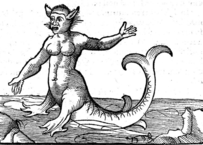
-p-363.jpg)
